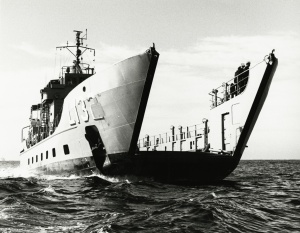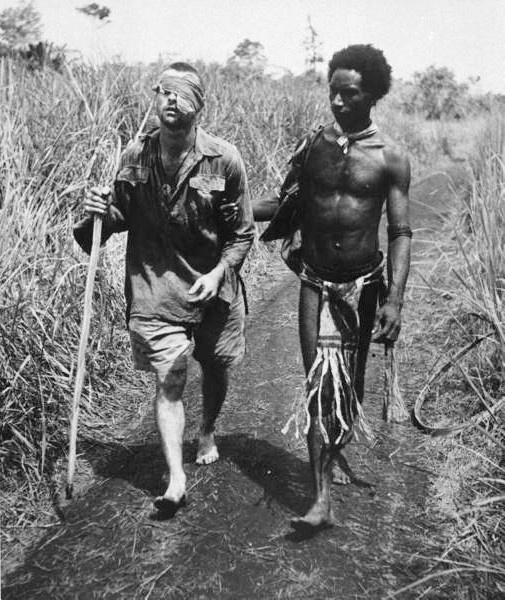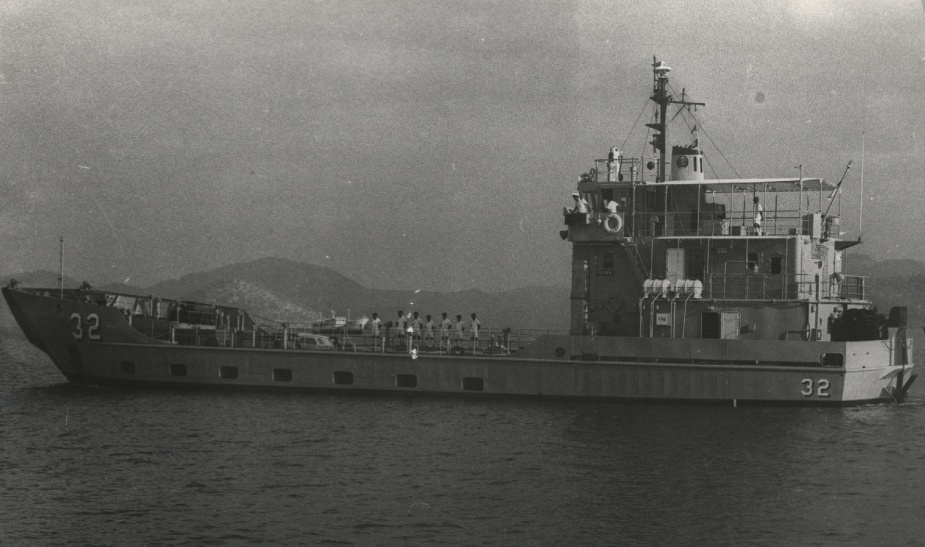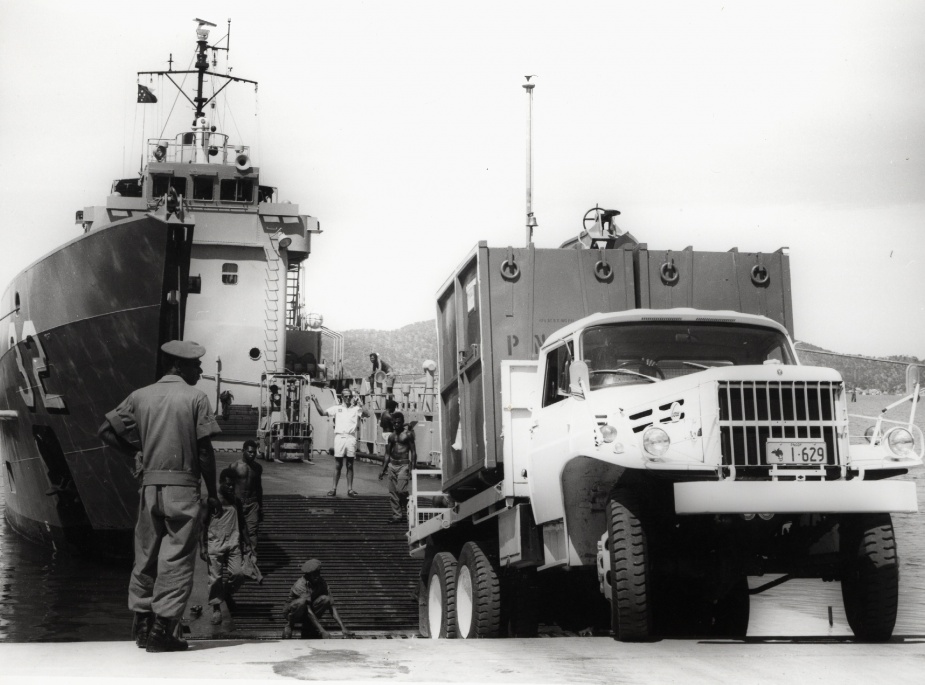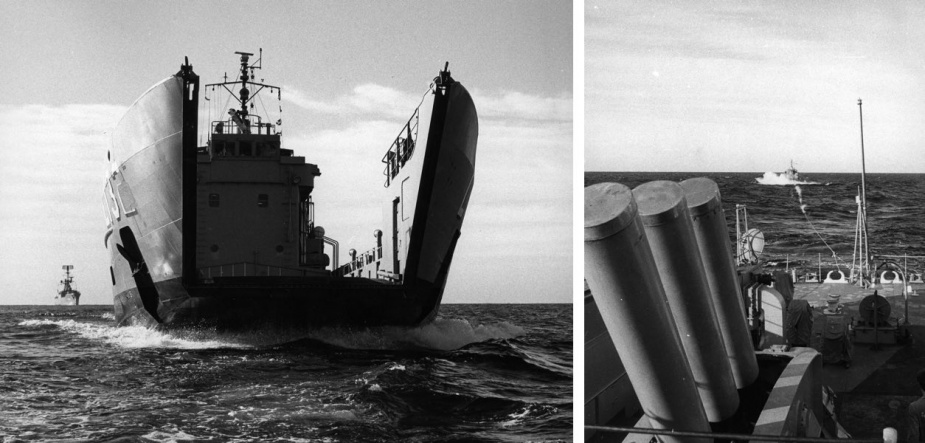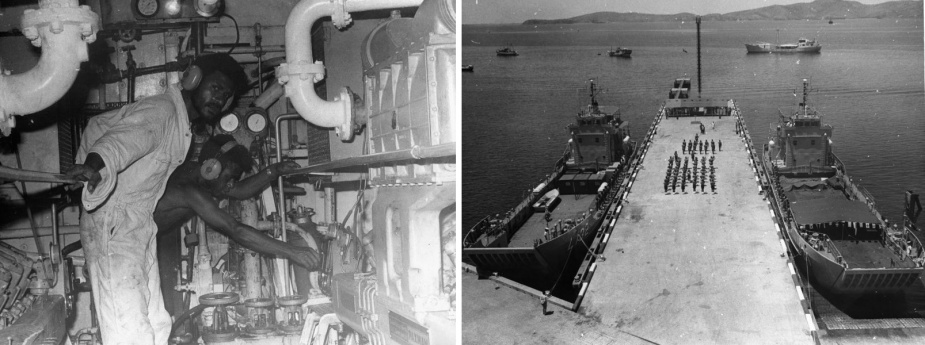HMAS Buna
| Class |
Balikpapan Class |
|---|---|
| Type |
Landing Craft Heavy |
| Pennant |
L132 |
| Motto |
Never Despair |
| Builder |
Walkers Ltd, Maryborough Queensland |
| Launched |
26 September 1972 |
| Commissioned |
7 December 1973 |
| Decommissioned |
26 November 1974 |
| Dimensions & Displacement | |
| Displacement | 364 tonnes (loaded, 517 tonnes) |
| Length | 44.5 metres |
| Beam | 10.1 metres |
| Draught | 2 metres |
| Performance | |
| Speed | 10 knots |
| Range | 3000 nautical miles |
| Complement | |
| Crew | 13 |
| Propulsion | |
| Machinery | 2 x Caterpiller 3406 diesels |
| Armament | |
| Guns | 2 x 12.7mm machine guns |
| Radars | Racal Decca Bridgemaster |
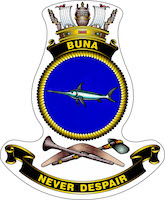
HMAS Buna (L132) was named after the landing of Australian troops by HMA Ships Colac, Ballarat and Broome on the Papua New Guinean coast near Buna in November 1942 against fierce Japanese opposition. The famous image of the wounded Private George ‘Dick’ Whittington being assisted by Papuan orderly Raphael Oimbari was taken at Buna on Christmas Day 1942.
Buna was one of eight vessels of the 311-503 tons full-load Balikpapan Class LCHs which were initially ordered for the Army Water Transport Units, until a Department of Defence decision in the early 1970s brought all ADF sea-going vessels under the Navy's wing, and the class was jointly manned. All of the Australian-designed ships were built by Walkers Ltd at Maryborough in Queensland and formed the First Australian Landing Craft Squadron based at HMAS Moreton in the Brisbane River.
Buna commissioned into the Royal Australian Navy (RAN) on 7 December 1973 at Moreton under the command of Lieutenant Martin Smith, RAN, and began work up on 10 December.
Buna visited Sydney for the first time on 16 January 1974 to embark a load of steel bound for Maryborough and was forced to avoid Tropical Cyclone Wanda on the return trip. She returned to Sydney the following month, again forced to seek shelter due to inclement weather, after a visit to Williamstown was cancelled. She participated in Army Exercise LONGBEACH between Sydney and Port Stephens.
Army support became her main task for her brief commission in the RAN. She provided support for Exercise KENTIA PALM transporting supplies and vehicles to Lord Howe Island, and provided general Army support off the New South Wales coast before returning to Brisbane on 28 March.
She continued to provide Army support off the Queensland coast before participating in Exercise KANGAROO ONE in June in the Shoalwater Bay area. KANGAROO ONE was Australia’s largest multi-national defence exercise and, in 1974, included armed forces from Australia, New Zealand, the UK and the USA. Some 15,000 servicemen (3500 RAN), 38 ships (22 RAN) and 200 aircraft participated.
By the end of the month, Buna was back in Sydney providing support for Exercise KENTIA PALM. On a return voyage to Sydney on 19 July the bow door separated and was lost into the sea forcing Buna to stop and turn stern-to into the sea. HMAS Parramatta took Buna under what proved to be a problematic tow and they returned to Sydney on 24 July.
Preparations began for a replacement door to be fitted. By this time, it was known that Buna, along with her sister ship, HMAS Salamaua, was to be made a gift to the fledgling Papua New Guinea Defence Force (PNGDF). Buna went into dry dock in September for her bow door replacement and for modifications pending her transfer to the PNGDF.
The PNG crew arrived in Sydney on 10 October and the ship cast off on 16 October for work up and passage to Brisbane, where she arrived three days later. Training continued for the PNG crew off the Queensland coast.
On 11 November Buna and Salamaua commenced passage to Port Moresby stopping to off-loading cargo at Horn Island, their last operation as units of the RAN. They arrived in Port Moresby on 23 November. Both ships decommissioned at 11.30am on 26 November and officially recommissioned into the PNGDF at midday. Lieutenant Smith had commanded Buna for the entirety of her commission in the RAN and remained in command when she recommissioned into the PNGDF giving him the rare distinction of twice being the commissioning Commanding Officer of the same vessel.

